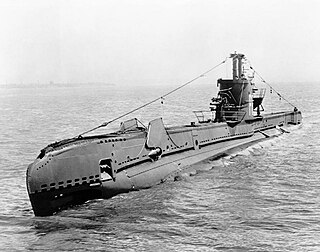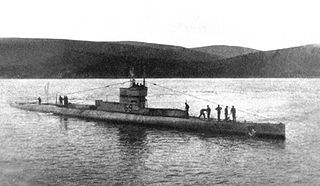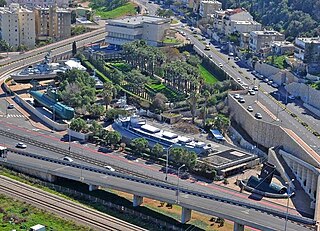
The Type 212A is a class of diesel-electric submarine developed by Howaldtswerke-Deutsche Werft AG (HDW) for the German Navy, and the Italian Navy where it is known as the Todaro class. It features diesel propulsion and an additional air-independent propulsion (AIP) system using Siemens proton-exchange membrane (PEM) compressed hydrogen fuel cells. The submarines can operate at high speed on diesel power or switch to the AIP system for silent slow cruising, staying submerged for up to three weeks with little exhaust heat. The system is also said to be vibration-free and virtually undetectable.

The Finnish Navy is one of the branches of the Finnish Defence Forces. The navy employs 2,300 people and about 4,300 conscripts are trained each year. Finnish Navy vessels are given the ship prefix "FNS", short for "Finnish Navy ship", but this is not used in Finnish language contexts. The Finnish Navy also includes coastal forces and coastal artillery.

The Royal Navy's T class of diesel-electric submarines was designed in the 1930s to replace the O, P, and R classes. Fifty-three members of the class were built just before and during the Second World War, where they played a major role in the Royal Navy's submarine operations. Four boats in service with the Royal Netherlands Navy were known as the Zwaardvisch class.

The Dolphin class is a diesel-electric submarine developed in Israel and constructed by Howaldtswerke-Deutsche Werft AG (HDW) in Kiel, Germany, for the Israeli Navy. The first boats of the class were based on the export-only German 209-class submarines, but modified and enlarged. The Dolphin 1 sub-class is slightly larger than the German Navy Type 212 in length and displacement. The three newer air-independent propulsion (AIP) equipped boats are similar to the Type 212 vessels in underwater endurance, but are 12 metres (39 ft) longer, nearly 500 tonnes heavier in submerged displacement and have a larger crew than either the Type 212 or the Type 214.

The Israeli Navy is the naval warfare service arm of the Israel Defense Forces, operating primarily in the Mediterranean Sea theater as well as the Gulf of Eilat and the Red Sea theater. The current commander in chief of the Israeli Navy is Aluf David Saar Salama. The Israeli Navy is believed to be responsible for maintaining Israel's offshore nuclear second strike capability.

Sa'ar 5 is a class of Israeli Navy corvettes. They were Israeli designed using lessons learned from the Sa'ar 4.5-class missile boats. Three Sa'ar 5 ships were built by Huntington Ingalls Industries for the Israeli Navy, based on Israeli designs.

The S-class submarines of the Royal Navy were originally designed and built during the modernisation of the submarine force in the early 1930s to meet the need for smaller boats to patrol the restricted waters of the North Sea and the Mediterranean Sea, replacing the British H-class submarines. As part of the major naval construction for the Royal Navy during the Second World War, the S class became the single largest group of submarines ever built for the Royal Navy. A total of 62 were constructed over a period of 15 years, with fifty of the "improved" S class being launched between 1940 and 1945.

A missile boat or missile cutter is a small, fast warship armed with anti-ship missiles. Being smaller than other warships such as destroyers and frigates, missile boats are popular with nations interested in forming a navy at lower cost. They are similar in concept to the torpedo boats of World War II; in fact, the first missile boats were modified torpedo boats with the torpedo tubes replaced by missile tubes.

The Type 206 is a class of diesel-electric submarines (U-boats) developed by Howaldtswerke-Deutsche Werft (HDW). Its design is based on the preceding Type 205 submarine class. These small and agile submarines were built during the Cold War to operate in the shallow Baltic Sea and attack Warsaw Pact shipping in the event of military confrontation. The pressure hulls were built out of non-magnetic steel to counter the threat of magnetic naval mines and make detection with MAD sensors more difficult. The low emission profile allowed the submarines in exercises to intrude even into well-protected opposing forces such as carrier formations with their screen.

The Royal Navy Submarine Service is one of the five fighting arms of the Royal Navy. It is sometimes known as the Silent Service, as submarines are generally required to operate undetected.

The Royal Navy's G class of diesel/electric submarines were launched between 1914 and 1917, and intended for operations in the North Sea and German Bight in World War I against German U-boats.

Zeev Almog, was the Commander In Chief (C.I.C.) of the Israeli Navy from 1979 to 1985. He was also General Manager of Israel Shipyards from 1986 to 1995.

IDAS is a medium-range missile currently being developed for the Type 209 and Type 212A submarine class of the German Navy.

The Type 209 is a range of diesel-electric attack submarines developed exclusively for export by Howaldtswerke-Deutsche Werft of Germany. Five class variants, including modifications thereof, have been successfully exported to 15 countries, with 68 submarines being built and commissioned to five different variants between 1971 and 2021. More boats have been built to modified designs.

HMS Zealous was a Z-class destroyer of the Royal Navy built in 1944 by Cammell Laird. She served during the Second World War, participating in operations in the North Sea and off the Norwegian coast, before taking part in some of the Arctic convoys. She spent a further ten years in Royal Navy service after the end of the war before being sold to the Israeli Navy, which operated her as INS Eilat. She saw action during the Suez Crisis in 1956 attacking Egyptian ships, and was still active by the outbreak of the Six-Day War in 1967. She was sunk several months after the conflict by missiles launched from several small Egyptian missile boats; this made her the first vessel to be sunk by a missile boat in wartime. It was an important milestone in naval surface warfare, which aroused considerable interest around the world in the development of small manoeuvrable missile boats.

HMS Sickle was a third-batch S-class submarine built for the Royal Navy during World War II. Completed in 1942, she made her initial war patrol off the Norwegian coast. Sickle then sailed to Gibraltar, from where she conducted one patrol, then to Algiers, French North Africa. From 10 May to 10 October, the boat patrolled the Gulf of Genoa five times and sank a German submarine as well as three minesweepers and an escort ship. She then moved to Beirut, French Lebanon, and conducted two patrols in the Aegean Sea, sinking three caïques and a merchant ship, in addition to landing resistance operatives in Greece.

HMS Springer was an S-class submarine of the Royal Navy, and part of the Third Group built of that class. She was built by Cammell Laird and launched on 14 May 1945. So far, she has been the only boat of the Royal Navy to bear the name Springer.

HMS Ultor (P53) was a Royal Navy U-class submarine built by Vickers-Armstrong at Barrow-in-Furness, launched in 1942, and part of the third group of the class. So far she has been the only ship of the Royal Navy to bear the name Ultor.

The Syrian Navy, officially the Syrian Arab Navy, is the navy branch of the Syrian Armed Forces. The main role of the Syrian Navy is to defend the country's coasts and ensure the security of the territorial waters of Syria. The Coastal Defense Forces and the Syrian Marines have been attached to the Navy since the late 20th century. The Syrian Navy is a relatively small navy with only 4,000 sailors, in addition to 2,500 reservists and 1,500 marines. It is under the Syrian Army's Latakia regional command with its fleet based in the ports of Baniyas, Latakia, Minet el-Beida, and Tartus. It is the smallest part of the Syrian Armed Forces.

The Clandestine Immigration and Naval Museum is a technical history museum located in Haifa, Israel.






















